|
Divi Neguma:
Regional development, the roadmap for Sri Lanka
by W.A.D.S. Gunasinghe
|
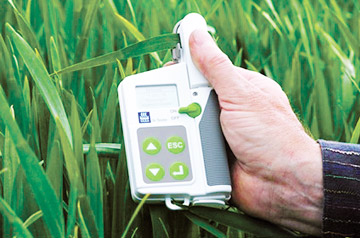
Precision agriculture: A hand tool to test the nitrogen
requirement of crops |
Sri Lanka witnessed a remarkable reduction in its poverty levels
during the last few years. The poverty headcount ratio that reflects the
percentage of the population living below the official poverty line has
dropped from 15.2 in 2006/07 to 8.9 in 2009/10. Poverty levels have
decreased across all sectors and geographical areas.
There were some districts where high poverty levels of over 20
percent have been persistent for the last two decades. All these
districts were able to reduce their poverty levels substantially during
the last few years.
See Graph 1
This is evidence of the sizeable elimination of structural poverty in
the country. This achievement well surpasses the internationally
accepted poverty reduction targets of the Millennium Development Goals
(MDGs) to halve the poverty levels of 1990 by 2015, ahead of time. In
this background, identifying the characteristics of remaining poverty
and the elimination of all facets of poverty are the main challenges
before the policymakers of the country.
|
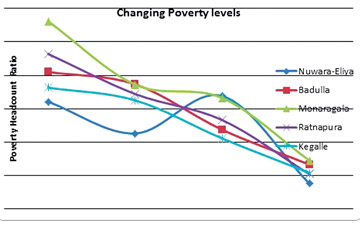
Graph 1: Changing poverty levels - Source: Department of Census
and Statistics. |
To this end, while increasing economic opportunities by improving the
capital asset base and thereby paving the way for the expansion of the
economy, the necessity of introducing a development program focused on
improving the wealth of the family has been recognised .
It is also observed that some indicators pertaining to individual
health such as malnutrition and anaemia are not commensurate with the
increased income of families. Further, the need has been felt for a new
approach in the wake of rapidly changing lifestyles, global food
insecurity and increasing demand for fresh and chemical-free vegetables
and fruits, having balanced and nutritional meals and also as a measure
of curtailing the cost of living.
In this background, the Divi Neguma program was launched by the
Government in 2011 with the view of promoting a backyard economy for
households, and thereby enhancing the wealth of the family. The
objective is not only to improve material wealth, but also to enhance
the mental, intellectual, physical and spiritual wealth of the
family.The program paid particular attention to uplift the living
standards of low-income families including 1.8 million people whose
income is below the poverty line, aiming at achieving the Government's
prime goal of a poverty-free Sri Lanka.
Generally, poverty can be the result of lacking capital, required
skills, marketing channels and other socio-economic opportunities. So
far, the poverty reduction approaches adopted had been mainly
transferring money to the family or focused on area-based development
programs aimed at improving the economic and social infrastructure and
service delivery in the localities. By these interventions, it was
expected that the causes of poverty can be eliminated.
However, diversity of families in terms of resources, assets and
skills has been mostly overlooked by these interventions and therefore
not been as effective as expected.
Eradicating poverty and sustaining it require the improvement of
family wealth so that the family can effectively share the benefits of
overall development of the country.
As it was mentioned earlier, the wealth of the family is not all
about money. It includes financial capital, human capital as well as
social capital. In this backdrop, Divi Neguma has its main focus on
improving the wealth of the family whereas the development of the area
will be considered from the perspective of the family.
Inception of Divi Neguma
The first phase of the Divi Neguma program was aimed at establishing
one million household economic units in Sri Lanka. The activities
promoted were home gardening, animal husbandry, fisheries, cottage
industries and marketing. Depending on the needs, planting materials
such as vegetable seeds and plants, coconut seedlings, fruit plants,
minor export crops and medicinal plants to be grown in home gardens had
been distributed among beneficiary families. The vegetables distributed
included green chillies, brinjals, bitter gourd, snake gourd, ladies
fingers and capsicum.
|
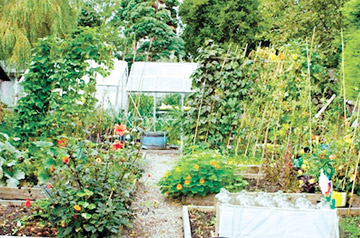
A kitchen garden |
Three different packages of vegetable planting material were given to
three identified zones i.e. upcountry, wet and intermediate zone and dry
zone. The aim was to meet the day-to-day requirements of the family
through these commodities. Many families who didn't have any interest in
growing any kind of food crop in their home garden have started growing
these crops under Divi Neguma.
Small-scale and easy to manage farming has led to rising enthusiasm
for raising crops among many families who didn't have much experience in
agricultural activities. Schoolchildren and elderly people in the
families have shown a great interest in this.
The harvest of vegetables has been mainly used for household
consumption and distributing among relatives and friends. It has also
helped ease the cost of living of these families. Particularly, it is
worthwhile to note that vegetables such as green chillies, capsicum and
tomato have shown high retail prices of over Rs. 300 per kilogram during
some months. Therefore, for the families who were already engaged in
some agricultural activity and whose main livelihood was agriculture,
this has become an opportunity to earn an additional income.
See Graph 2
|
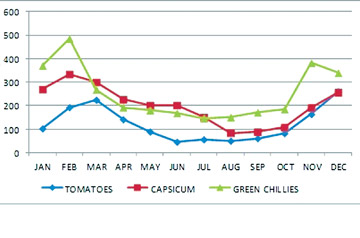
Graph 2: Average monthly retail prices of tomatoes, capsicum and
green chillies 2011 (Colombo and suburbs).Source: Hector
Kobbekaduwa Agrarian Research and Training Institute. |
Village level projects to popularise the growing of medicinal plants,
minor export crops and other field crops such as green gram, ground nuts
and onions, which have been non-traditional crops for some parts of the
country, have also been undertaken. This will also contribute to the
target of achieving self-sufficiency in certain food crops.
Along with the agricultural activities, livestock and inland
fisheries development activities to supplement household incomes and to
improve the family food basket have been promoted. Families have been
provided with 10 chicks each and facilities to build co-ops to increase
mainly egg production which is the cheapest source of protein.
Scaling of current activities
Some families were initially reported to be reluctant to accept
chicks, but once they realised that small-scale poultry farming can be
carried out within the home garden without, not only disturbing the
pleasant environment around the house, but also improving it, demand for
this activity has increased.
Pond fish culture is also a profitable household level industry that
has been promoted in certain areas of the country.
All these activities have been implemented through District and
Divisional Secretariats and the Samurdhi system. With the establishment
of the Divi Neguma Department under the Divineguma Act passed by
Parliament recently, the program will be scaled to be the driving force
of modernising and upgrading economic activities undertaken mainly by
low-income groups, small farmers, small entrepreneurs, informal sector
producers and small-scale traders.
There are three main pillars in the organisational structure of Divi
Neguma - Divi Neguma community organisations, Divi Neguma banks and Divi
Neguma Development Department. The first two institutions are
organisations managed by the community while the third one is a
government department. The officers in the Samurdhi Authority, Southern
Development Authority and Udarata Development Authority will be absorbed
into the Divi Neguma Department.
While harnessing the full potential of each individual and family in
economic activities, the program will expand beyond the family to a
network of community groups and further to the divisional and district
level networks, which in turn will help scale their income generation
activities and create facilities conducive for their livelihoods.
Undertaking of projects to create local level infrastructure and
services including roads, culverts, drinking water supply, irrigation
schemes, storage and marketing facilities and credit facilities through
Divi Neguma banks which are directly related to the livelihood will be
facilitated through this process.
All these arrangements will facilitate the scaling of current
economic activities engaged by the target groups in terms of technology,
quality and innovations.
International best practices
One of the best examples of similar initiatives in other countries is
Saemaul Undong in South Korea, which was able to completely modernise
the South Korean rural sector and improve the quality of life
tremendously. This program was introduced by Korea's late President Park
Chung-hee in the early 1970s.
By this time, South Korea's industrial sector was booming and the
income of people living in the urban sector has been much higher
compared to that of rural sector. It was reported that the average
income of the rural sector was 60 percent of the urban sector at that
time. One of the main thrusts was improving rural infrastructure through
participatory approach.
However, the program was not confined to that, various projects to
increase household income, popularising high yielding rice varieties,
land amelioration, seed improvement, providing boats for fishermen and
activities to improve living conditions such as replacing traditional
thatched roofs, improving house structures and fences, kitchen
facilities and improving toilets with modern accessories have been
carried out.
These have been followed by specific interventions to improve the
productivity of the agriculture sector, gain an additional income and
combine agriculture with manufacturing. Attention has been paid to
activities such as straightening rice field ridges and consolidating
creeks which seem to be simple, but have the ability to make a
significant change in productivity in the production systems.
Higher income
Then, the income of rural people become higher than that of the
urban. Consequently, the movement was expanded to manufacturing firms
and urban areas. Cultural aspects have not been overlooked by the
movement.
Saemaul Undong which literally means 'new village movement' tried to
harmonise modernisation of villages with values and traditions in South
Korea.
It mainly promoted three social values - diligence, self-help and
cooperation - which contributed to enhanced social integration. Finally,
it has become a national tool for bringing prosperity to the Korean
people.
The current agricultural practices in the country often do not pay
due attention to the critical stages of cultivation such as land
preparation, nursery and seed bed maintaining, early stages of planting
and harvesting which require the use of appropriate tools, techniques
and field practices that maximise the yield in terms of quantity and
quality.
Divi Neguma has high potential to disseminate this knowledge, skills
and best practices, not only for home gardening, but also to the entire
agriculture sector.
|
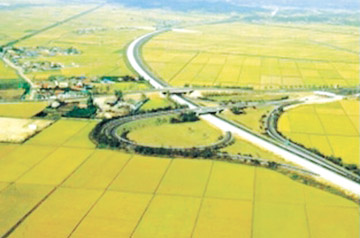
Saemaul Undong, modernised rural Korea |
Use of tools and machinery ranging from various hand tools to large
machineries such as combined harvesters makes the agricultural
operations more efficient. Use of appropriate tools for each and every
operation is particularly important.
The scale of growing crops in home gardens makes it possible for
growers to pay more attention to monitor germination and survival rates,
malnutrition symptoms, susceptibility to diseases and pests and
appropriateness of plant densities which are often overlooked when it
comes to comparatively large-scale cultivations.
The home garden is an appropriate place to popularise these habits
among growers.
This is applicable not only to home gardening and agriculture, but to
other household level livelihood and day-to-day activities as well.
Another area to be focused is production system improvement. The
examples for such system improvement are introduction of new farming
systems including crop rotating practices, improvement of existing
irrigation systems with modern technology, adopting precision
agriculture principles that specifically take intra-field variations
into account, introducing intensive growing systems such as poly
tunnels, introducing agro-processing plants, post-harvest technology
improvement, storage facility improvement and improving marketing
channels.
Towards an appropriate farm model
One of the challenges faced by Sri Lanka's agriculture sector is
introduction of suitable farm models for various parts of the country.
Divi Neguma provides an entry point to introduce suitable farm models
for different agro-ecological regions of the country. It is evident that
the home gardens in the dry zone are comparatively large with the extent
of usually up to two acres. The size of home gardens in the dry zone
provides a good opportunity to develop a small-scale family farm model
taking factors such as soil type, land form, topography, availability of
water, rainfall patterns and natural vegetation into account.
As this kind of farm will be based on part/full time family labour,
appropriate machinery has to be introduced. We should not forget the
fact that these families generally have a certain extent of paddy lands
where usually two cropping seasons are cultivated.
In the wet zone, home gardens are comparatively small. Even if the
land plots around the houses are quite large, they are generally
occupied by coconut, tea, rubber or sometimes minor export crops and
therefore the possibility of introducing a new farm model is remote. For
such small home gardens, the concept of the kitchen garden will be more
appropriate.
According to the Oxford Dictionary , "Kitchen garden is a garden or a
part of a garden in which vegetables and sometimes fruits or herbs are
grown especially for domestic use." The area of this kind of garden can
vary from about 1,000 to 1,500 square feet. Further, depending on the
conditions of the agro-climatic zones, suitable models can be introduced
for the other parts of the country as appropriate.
Improving environment
At the community level, Divi Neguma has to play an instrumental role
in improving the living environment of people. The community small
groups formed at villages have a specific role in achieving this
objective. While improving the community infrastructure such as rural
access roads, marketing facilities, solid waste management, drinking
water projects and irrigation facilities through a participatory
approach, emphasis is also given to improving household conditions such
as toilets and sanitary facilities, domestic waste management and
condition of houses - roofs, floors, kitchens and access to common
amenities. Improved household income, credit facilities through the Divi
Neguma banking system and attitudinal changes through peer group
interactions will facilitate this process.
Regional dimensions
The new regional development model of the Government is based on the
philosophy that believes in the potential of mobilising local resources
for regional growth and development contrary to the conventional
approach that mainly focused on transferring funds to improve the
conditions of the regions.
In line with that policy, identifying and mobilising the locally
available resources to promote new income generating activities and
upgrading existing economic activities at divisional level will be a
task that divisional Divi Neguma organisations should undertake.
Value addition of local products through the application of modern
technology, forming industrial clusters and improving the value chain to
improve competitiveness in local as well as international markets are
also among other tasks for divisional Divi Neguma organisations.
Coordinating, apprising and promoting community-based organisations
within the division are the responsibility of these divisional
organisations.
Efficiency-driven economy
Bringing the voice of the people at the grass-roots through district
to national level policymaking through a national council is an
important function of these organisations. In the meantime, the
Government development agenda has effectively to be conveyed to people
through the same set of organisations. To fulfil the objectives of Divi
Neguma, this two-way information flow is imperative. Having invested
substantially on infrastructure over the past several years
consecutively, the economy was able to expand its ability to use the
full potential of the existing production factors.
The next level of development is based on increasing productivity
with efficient use of resources in all sectors. For this purpose, it is
necessary to make production processes, labour, goods and financial
markets efficient and facilitate increased use of high-tech with skilled
labour force.
It is observed that according to statistics, around 63 percent of the
labour force of the country is engaged in informal economic activities.
These activities include small-scale farming and livestock, cottage
industries, fishing, petty trading, daily wage labour and activities
related to local service provision. Needless to say, improving
productivity in these areas will have a great impact on the overall
performance of the economy. While improving the wealth of families, the
main focus of Divi Neguma therefore should be aimed at increasing
competitiveness in these sub-sectors which can make a real difference in
the development roadmap of the country.
(The views and opinions expressed herein are those of the author and
do not necessarily reflect the views of the institution he is attached
to.)
The writer is Director, Department of National Planning which comes
under the Ministry of Finance and Planning.
|



